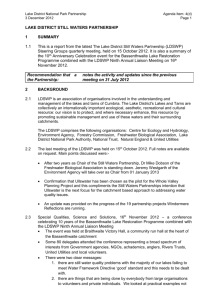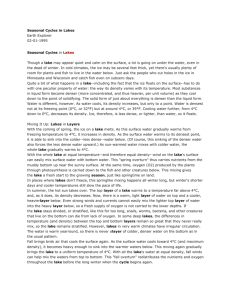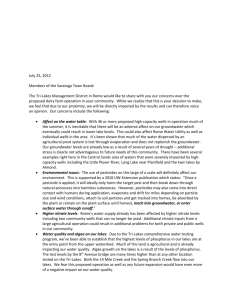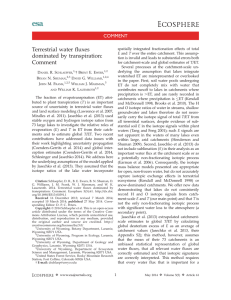Submission in General on Designation of Sensitive Lakes Zone
advertisement
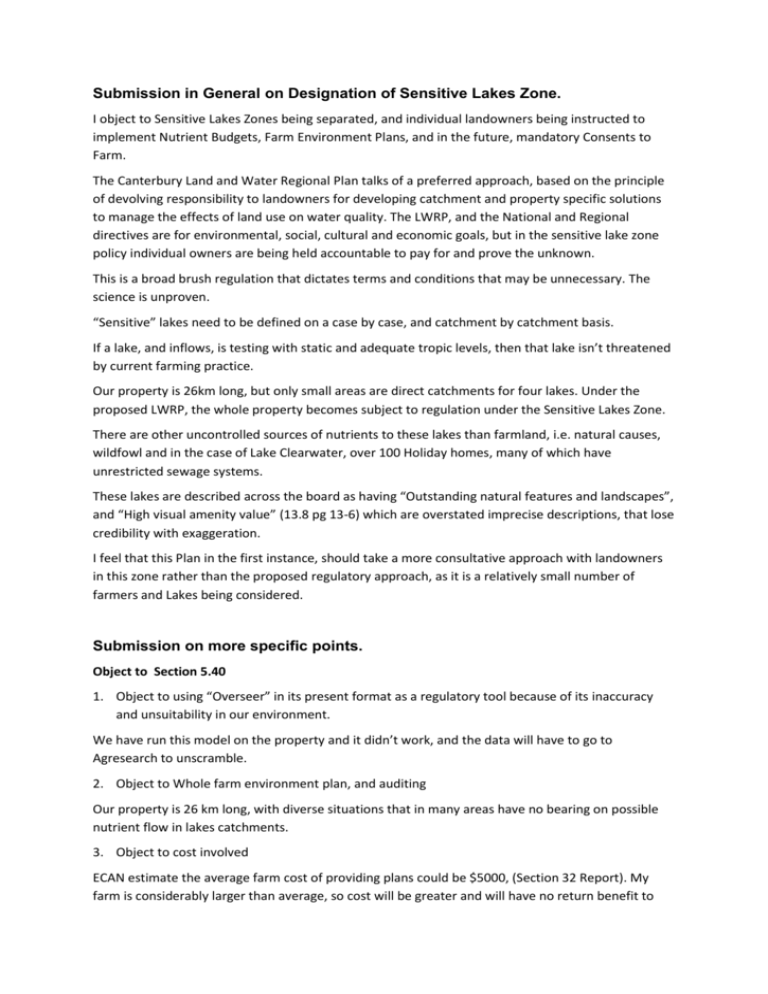
Submission in General on Designation of Sensitive Lakes Zone. I object to Sensitive Lakes Zones being separated, and individual landowners being instructed to implement Nutrient Budgets, Farm Environment Plans, and in the future, mandatory Consents to Farm. The Canterbury Land and Water Regional Plan talks of a preferred approach, based on the principle of devolving responsibility to landowners for developing catchment and property specific solutions to manage the effects of land use on water quality. The LWRP, and the National and Regional directives are for environmental, social, cultural and economic goals, but in the sensitive lake zone policy individual owners are being held accountable to pay for and prove the unknown. This is a broad brush regulation that dictates terms and conditions that may be unnecessary. The science is unproven. “Sensitive” lakes need to be defined on a case by case, and catchment by catchment basis. If a lake, and inflows, is testing with static and adequate tropic levels, then that lake isn’t threatened by current farming practice. Our property is 26km long, but only small areas are direct catchments for four lakes. Under the proposed LWRP, the whole property becomes subject to regulation under the Sensitive Lakes Zone. There are other uncontrolled sources of nutrients to these lakes than farmland, i.e. natural causes, wildfowl and in the case of Lake Clearwater, over 100 Holiday homes, many of which have unrestricted sewage systems. These lakes are described across the board as having “Outstanding natural features and landscapes”, and “High visual amenity value” (13.8 pg 13-6) which are overstated imprecise descriptions, that lose credibility with exaggeration. I feel that this Plan in the first instance, should take a more consultative approach with landowners in this zone rather than the proposed regulatory approach, as it is a relatively small number of farmers and Lakes being considered. Submission on more specific points. Object to Section 5.40 1. Object to using “Overseer” in its present format as a regulatory tool because of its inaccuracy and unsuitability in our environment. We have run this model on the property and it didn’t work, and the data will have to go to Agresearch to unscramble. 2. Object to Whole farm environment plan, and auditing Our property is 26 km long, with diverse situations that in many areas have no bearing on possible nutrient flow in lakes catchments. 3. Object to cost involved ECAN estimate the average farm cost of providing plans could be $5000, (Section 32 Report). My farm is considerably larger than average, so cost will be greater and will have no return benefit to my business. The benefits of the LWRP are for the wider ‘public good’, therefore I believe the initial costs should be contributed directly from the public purse, to set the benchmark plans for farms. If the landowner fails to reach or maintain good management standards or target thresholds, then they should pay. Those properties inside the lake zones have been singled out and treated differently and unfairly. Other zones that are also deemed at risk, but they don’t all have to submit environment plans, do on-going audits, or pay for, and apply for consents to farm(5.49) if they are within guidelines of ‘look-up tables’. Object To Schedule 6, pg 16-12 These 28 areas on rivers and lakes commonly used for bathing, have stock exclusion zones upstream. Two areas are bordering my farm, Lake Camp and Lake Clearwater. All sites here other than Lake Camp have a 1000m exclusion distance, yet Lake Camp has a 2000m distance, which as written, covers a large area of my farm. This is, in both sites, impractical, extreme and unnecessary. There has been no restriction on swimming at either site in recent times due to any stock pollution, although there is an ongoing high risk of “Duck Itch”. Object To Flow Sensitive Catchments 13.7 pg 13.5 With regard to Lambies Stream and “whole Catchment” deemed Sensitive. This stream meanders through part of my farm, and I am concerned with the vagueness , and possible implications of statement in 13.7 that reads “the following are to be applied when reading relevant policies and rules in Sections 4 and 5”. I am also concerned with the undefined meaning of “sensitive” in this case. The only clarification that I can find in the wider LWRP relates to sensitive catchments and Trees, and that has no relevance on this stream. Object to Stock Exclusion From Water bodies 5.133 pg 5-30 I run an extensive property with extensive grazing systems and to exclude stock from water bodies is impractical with fencing. If current practices are not disturbing these sites to their detriment, why can’t we retain the status Quo. Object to Estimated number of properties in each sensitive lake catchment. Table 6 pg 48, and Table 5 pg 75 Section 32 report. Both these tables state an incorrect number of farms in several of these catchments, i.e. Lake Camp and Clearwater listed with two farms each, but there is only one farm in both cases. Lake Emily, and Maori Lakes claim 4 and 5 respectively, but again this is inaccurate.
